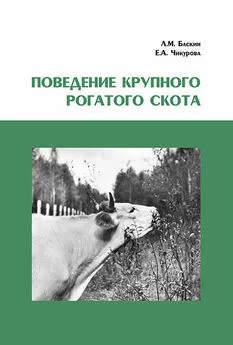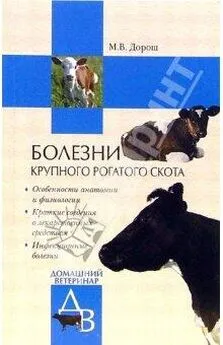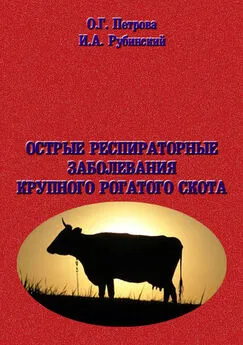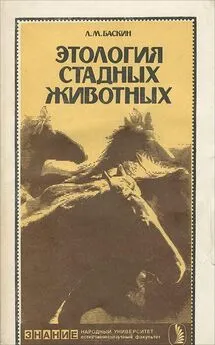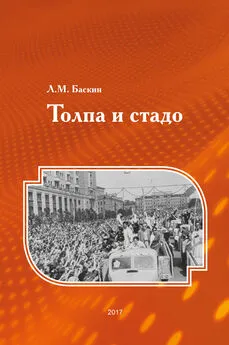Леонид Баскин - Поведение крупного рогатого скота
- Название:Поведение крупного рогатого скота
- Автор:
- Жанр:
- Издательство:Товарищество научных изданий КМК
- Год:2014
- Город:Москва
- ISBN:978-5-9906181-0-7
- Рейтинг:
- Избранное:Добавить в избранное
-
Отзывы:
-
Ваша оценка:
Леонид Баскин - Поведение крупного рогатого скота краткое содержание
Книга будет полезна для ученых-зоотехников, профессоров и студентов, изучающих экологию, этологию и физиологию крупного рогатого скота, а также для немногих работающих в России исследователей поведения этого важнейшего для человека домашнего животного.
Поведение крупного рогатого скота - читать онлайн бесплатно ознакомительный отрывок
Интервал:
Закладка:
Pruitt W.O. 1960. Behaviour of the barren-ground caribou // University of Alaska Biological Papers. N 3.
Purcell D., Arave C.W., Walters J.L. 1998. Relationship of three measures of behavior to milk production // Applied Animal Behaviour Science. Vol. 21. P. 307–313.
Ralls K., Kranz K., Lundrigan B. 1986. Mother-young relationships in captive ungulates: variability and clustering // Animal Behaviour. Vol. 34. P. 134–145.
Redbo I. 1990. Changes in duration and frequency of stereotypies and their adjoining behaviours in heifers, before, during and after the grazing period // Applied Animal Behaviour Science. Vol. 26. P. 57–67.
Redbo I. 1992. The influence of restraint on the occurrence of oral stereotypies in dairycows // Applied Animal Behaviour Science. Vol. 35. P.115–123.
Redbo I., Jacobson K.G., van Doorn C., Petterson G. 1992. A note on relations between oral stereotypies in dairy cows and milk production, health and age // Animal Production. Vol. 54. P.166–168.
Redburn M. J., Strong W.L, Gates C.C. 2008. Suitability of boreal mixedwood clearcuts as wood bison ( Bison bison athabascae ) foraging habitat in north-central Alberta, Canada Forest // Ecology and Management. Vol. 255. № 7. P. 2225–2235.
Rehkamper G., Gorlach A. 1998. Visual identification of small sizes by adult dairy bulls // J. of Dairy Science. Vol. 81. P. 1574–1580.
Reinhardt V. 1983. Flehmen, mounting and copulation among members of semi-wild cattle herd // Animal Behaviour. Vol. 31. P. 641–650.
Reinhardt V., Reinhardt A.1981. Cohesive Relationships in a Cattle herd ( Bos indicus ) // Behaviour. Vol. 77. № 3. P.121–150.
Ridpath M.G. 1991. Feral mammals and their environment // Monsoonal Australia landscape, ecology and men in the Northen lowlands. NT Press. P. 169–195.
Rind M.I., Phillips C.J.C. 1999. The effects of group size on the ingestive and social cost of walking // Animal Production. Vol. 25. P. 107–110.
Riol J.A., Sanchez J.M., Eguren V.G., Gaudioso V.R. 1989. Colour perception in fighting cattle // Applied Animal Behaviour Science. Vol. 23. P. 199–206.
Ropiquet A., Gerbault-Seureau M., Deuve J.L., Gilbert C., Pagacova E., Chai N., Rubes J., Hassanin A. 2008. Chromosome evolution in the subtribe Bovina (Mammalia, Bovidae). The karyotype of the Cambodian banteng ( Bos javanicus birmanicus ) suggests that Robertsonian translocations are related to interspecific hybridization // Chromosome Research. Vol. 16. № 8. P. 1107–1118.
Roth J. 2004. Bubalus bubalis // Animal Diversity Web.
http://animaldiversity.ummz.umich.edu/
Ruckenbush Y. 1972. The relevance of drowsiness in the circadian cycle of farm animals // Animal Behaviour. Vol. 20. P. 637–643.
Rushen J., dePasille A.M.B., Munksgaard, L. 1999. Fear of people by cows and effects on milk yield behavior and heart rate at milking // J. of Dairy Science. Vol. 82. P. 720–727.
Rybarzyk P., Koba Y., Rushen J., Tanida H., de Passille A.M. 2001. Can cows discriminate people by their faces? // Applied Animal Behaviour Science. Vol. 74. P. 175–189.
Sambraus H.H., Gotthardt A. 1985. Prepuce sucking and tongue rolling in intensively fattened bulls // Deutsche Tierarztliche Wockenschrift. Vol. 92. P. 465–468.
Sânchez J.M., Riol J.A., Castro M.J., Gaudioso V.R. 1990. Comportamiento del toro de Lidia frente al caballo y muleta. P. aspectos aplicativos en la raza // Archivos Zootec. Vol. 39. P. 165–174.
Sato S. 1984. Social licking pattern and its relationships to social dominance and liveweight gain in weaned calves // Applied Animal Behaviour Science. Vol. 12. P. 25–32.
Sato S., Nagamine R., Kubo T. 1994. Tongue-playing in tethered Japanese Black cattle; diurnal patterns, analysis of variance and behavior sequences // Applied Animal Behaviour Science. Vol. 39. P. 39–47
Schofield S.A.A., Phillips C.J.C., Owens A.R. 1991. Variation in the milk production activity rate and electrical impedance of cervical mucus over the estrous period of dairy cows // Animal Reproduction Science. Vol. 24. P. 231–248.
Scott J. P. 1945. Social behaviour, organization and leadership in a small flock of domestic sheep//Comparative Psychology Monographs. Vol. 96. N 18(4).
Scott J.P., Fuller J.L. 1965. Genetics and the social behaviour of the dog. Chicago, London, University of Chicago Press. 468 p.
Schein M.W., Fohrman M.H. 1955. Social dominance relationships in a herd of dairy cattle // British J. of Animal Behaviour. Vol. 3. P. 45–55.
Schloeth, R. Das sozialleben des Camargue-Rhindes. // Z. Tierpsychol. 1961, 574–627.
Seabrook M.F., Bartle N.C. 1992. Human factors influencing the production and welfare of animals // In: Phillips C.J.C., Piggins D. (eds) Farm Animals and the Environment. Commonwealth Agricultural Bureaux, Slough. P. 111–130.
Seo T., Sato S., Kosaka K., Sakamoto N., Tokumoto K., Katoh K. 1998. Development of tongue-playing in artificially reared calves: effects of offering a dummy-teat, feeding of short cut hay and housing system // Applied Animal Behaviour Science. Vol. 56. P.1–12. Seton E.T. 1927. Game animals of North America, V. III. N. Y.
Seufert H. 1997. Stall barn forms for daily cows under regard of animal physiology and profitability // Zuchtungskunde. Vol. 69. P. 421–434.
Seiliez J.P. 1999. Breve presentación de la raza Betizu //Naturzale. Vol. 14. P. 67–72.
Senani S., Rai R.B., Chatterjee R.N., Sunder J., Kundu A. 2004. GIS Based Analysis of Livestock Production System in Andaman and Nicobar Islands // GISDECO. P. 1–3 Sheridan T.E. 2012. Arizona: a history. USA. Univ.of Arizona Press. 488 pp.
Sherley G., Lowe S. 2000. Towards a regional invasive species strategy for the South Pacific: issues and options // Invasive species in the Pacific: review and draft regional strategy. South Pacific Regional Environment Programme. Apia, Samoa. SPREP. P. 7–18.
Silva B., Gonzalo A., Canon J. 2006. Genetic parameters of aggressiveness, ferocity and mobility in the fighting bull breed // Animal Researches. Vol. 55. P. 65–70.
Silva-Mena C., Aké-López R., Delgado-León R. 2000. Sexual behavior and pregnancy rate of Bos indicus bulls // Theriogenology. Vol. 53. N 4. P. 991–1002.
Skarpe C.,Bergström R., Bråten A. L., Danell K. 2000. Browsing in a Heterogeneous Savanna // Ecography. Vol. 23. N. 5. Р. 632–640
Skinner B.F. 1938. Behavior of Organisms: An Experimental Analysis. New York. AppletonCentury-Crofts. 320 рр.
Soesanto M., Soeharsono S., Budiantono A., SuIistyana K., Tenaya M., Wilcox G.E. 1990. Studies on experimental Jembrana disease in Bali cattle. Clinical signs and haemalological changes // J. of Comparative Pathology. Vol. 103. P.61–71.
Soffie M., Thines G., Falter U. 1980. Color discrimination in heifers // Mammalia. Vol. 44. P. 97–121.
Solano J., Orihuela A., Galina C.S., Montiel F., Galindo F. 2005. Relationships between social behaviour and mounting activity of Zebu cattle ( Bos indicus) // Applied Animal Behaviour Science. Vol. 94. № 3. P. 197–203.
Soper J.D. 1941. History, range and home life of the Northern bison // Ecological Monographs, II. № 4. P. 347–412.
Steffen W., Burbidge A.A., Hughes L., Kitching R., Lindenmayer D., Musgrave W., Stafford Smith M., Werner P.A. 2009. Australia’s biodiversity and climate change: a strategic assessment of the vulnerability of Australia’s biodiversity to climate change. A report to the Natural Resource Management Ministerial Council commissioned by the Australian Government. CSIRO Publishing. 303 рp.
Steinmetz R. 2004. Gaur ( Bos gaurus ) and Banteng ( Bos javanicus ) in the lowland forest mosaic of Xe Pian Protected Area, Lao PDR: abundance, habitat use, and conservation // Mammalia. Vol. 68. № 2–3. P. 141–157.
Stephens D.B., Jones J.N. 1975. Husbandry influences on some physiological parameters of emotional responses in calves // Applied Animal Ethology. Vol. 1. P. 233–243.
Stinson D.W., Glass P.O., Taisacan E.M. 1992. Declines and Trade in Fruit Bats on Saipan, Tinian, Aguijan, and Rota // Pacific Island Flying Foxes: Proceedings of an International Conservation Conference. Biological report. Vol. 90. № 23. P. 61–67.
Stone C.P., Anderson S.J. 1988. Introduced animals in Hawaii’s natural areas // Proceedings of the Thirteenth Vertebrate Pest Conference 1988. Р. 133–142.
Swinnerton K., Pott M., Hall T. 2010. Restoration of Isla Cabritos for the protection of Ricord’s Iguana and Rhinoceros Iguana // Island Conservation. Santa Cruz. CA 95060. 35 pp.
Terlouw E.M.C., Boissy A., Blinet P. 1998. Behavioral responses of cattle to the odours of blood and urine conspecifics and to the odour of faeces from carnivores // Applied Animal Behaviour Science. Vol. 57. P. 9–21.
Thornback J. 1983. Wild cattle, bison and buffaloes: their status and potential value. Cambridge, UK. IUCN Conservation Monitoring Centre. 64 pp.
Thomson P.C. 1992a. The behavioural ecology of dingoes in north-western Australia. III. Hunting and feeding behaviour, and diet // Wildlife Research. Vol.19. P. 531–41.
Thomson P.C. 1992b. The behavioural ecology of dingoes in north-western Australia. IV. Social and spatial organization, and movement // Wildlife Research. Vol.19. P. 543–63.
Timmins, R.J., Duckworth, J.W., Hedges, S., Steinmetz, R., Pattanavibool, A. 2008. Bos javanicus // In: IUCN 2013. IUCN Red List of Threatened Species. Version 2013.
Veissier I., Rushen R., Colwell D., de Passille A.M. 2000. A laser-based method for measuring thermal nociception of cattle // Applied Animal Behaviour Science. Vol. 66. P. 289–304.
Vigne J.-D. 2011. The origins of animal domestication and husbandry: A major change in the history of humanity and the biosphere // Comptes Rendus. Biologies. Vol. 334. P. 171–181.
Venkataraman A. B., Arumugam R., Sukumar R. 1995. The foraging ecology of dhole ( Cuon alpinus ) in Mudumalai Sanctuary, Southern India // J. Zoology. Vol. 237. P. 543–561.
Vitale A.F., Tenucci M., Papini M., Lovari S. 1986. Social behaviour of the calves of semiwild Maremma cattle, Bos primigenius taurus // Applied Animal Behaviour Science. Vol. 16. P. 217–231.
Voisin B.D., Grandin T., Tatum J.D., O’Connor S.F., Struthers J.J. 1997. Feedlot cattle with calm temperaments have higher average daily weight gains than cattle with excitable temperaments // J. of Animal Science. Vol. 75. P. 892–896.
Walther F.R. 1984. Communication and expression in hoofed mammals. Bloomington. Indiana university press. 423 pp.
Waynert D.F., Stookey J.M., Schwartzkopf-Genswein K.S., Watts J.M., Waltz C.S. 1999. The response of beef cattle to noise during handling // Applied Animal Behaviour Science. Vol. 62. P. 27–42.
Webster A.J.F. 1984. Calf Husbandry, Health and Welfare. Granada Publishing. London.
Werner P.A. 2005. Impact of feral water buffalo and fire on growth and survival of mature savanna trees: An experimental field study in Kakadu National Park, Northern Australia //Australian Ecology. Vol. 30. № 6. P. 625–647.
Wiepkema P.R., Van Hellemond K.K., Roessing P., Romberg H. 1987. Behaviour and abomasal damage in individual veal calves // Applied Animal Behaviour Science. Vol. 18. P. 257–268.
Wiepkema P.R. 1983. On significance of ethological criteria for the assessment of animal welfare // Current Topics in Veterinary Medicine. Vol. 23. P. 71–79.
Wigglesworth A. 1992. Falkland people. Peter Owen Limited. 136 pp.
Wilson L.L., Terosky T.L., Stull C.L., Stricklin W.R. 1999. Effects of individual housing design and size on behavior and stress indicators of special-fed Holstein veal calves // J.
Читать дальшеИнтервал:
Закладка:
